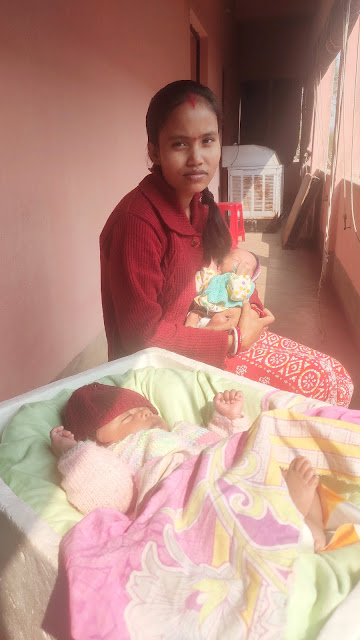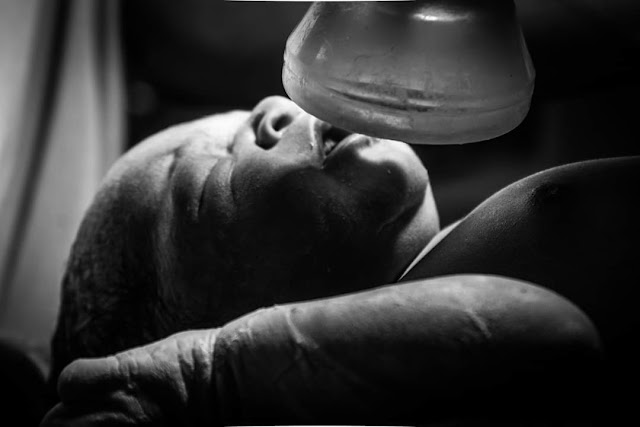Child Birth in Jan Chetna Manch
Lakshmi with her healthy baby. She was diagnosed with Type 2 DM, and managed with insulin. She delivered a healthy baby boy at the health center in chamrabad.
How will it feel like to live in a place where child birth is not totally medicalised? That was the primary thought when I packed my things to Chamrabad for a two month stay. Now I feel it is very much feasible and possible.
When my friend Pravin told me he is visiting the place for a few months, I decided without a second thought that I should also go again and spend some reasonable time there. My last visit was very brief, for only a week.
The Jan Chetna Manch health center is run by the women for the women, in it's true sense. The pivotal role of the mothers going through child birth as the priority and not a hierarchical decision making is what is re emphasised again and again in actions.
The story didn't start just with the NGO - Jan Chetna Manch, it starts with human birth itself. The experience is a summation of natural birth and science, both at the right doses. Both are not exclusive of each other and we often fail to understand in our field. The community program was very strong before the health center was started there. There are more than 500 women's groups comprising of more than 9000 women operational in close to 75 villages. The health center is what I'm sharing about, but the place and their work is much more than what is written here.
Lindsay Barnes, who runs their health center, is a sociologist by profession. She was born and brought up in England. She came to India to finish her Masters and stayed here ever since. She has been living in Chamrabad with her family for more than 30 years. One fine night, in 1993, she was called to help in a delivery in the village. She had no medical knowledge to aid childbirth, but the villagers insisted her to come since she was the most educated women in the village. She took "Where there is no doctor" (A masterpiece by David Werner - a Bible for grassroot community health work) and went there. The delivery happened all well and it gave her the drastic reality for the need for midwifery in the area.
In the initial years, she learnt midwifery from the local dais going from village to village in helping in deliveries. She has learnt midwifery and obstetrics all by herself and from all the dais. It is very unique compared to our medical college approach which is not community based. Now they have a fully functional 24 hour health center to handle deliveries, neonatal care and a strong, well knitted community health program for more than 70 villages. They have an average of 700-1000 deliveries a year. The most interesting part is, there is no resident doctor.
The health workers, called Swasthya Sakhis, does an incredible role in the villages by guiding the mothers through pregnancy and childbirth. For every out patient visit, they accompany every mother in their village to the health center. This is in a part of our country, where buses are still a dream. The swaasthya sakhis and the pregnant mothers take an auto or a bike trip to reach the hospital. They make sure that, everything has been done from investigations, examination to explaining everything to the family. They have a watch on whether the mothers take appropriate drugs they are prescribed. For a state with rampant malnutrition, the dedicated work by the Swasthya Sakhis can be seen in the nutritional status of women walking into the OPD. The prevalence of anemia is much less than how we see usually. They don't stop with antenatal visits, they stay with mothers during labour and even till they get discharged. If anyone gets referred, they go with them, be it baby or mother. Most of them were village dais before they were trained by the health center. Their knowledge of child birth was retained and few things in their knowledge were added from a scientific view. They always have set of gloves, a sterile blade, some clean clothes with them. Whenever anyone goes in labour form their village, they go examine the mother, do PV examination and decide based on the progress. If it's too late to go to the health center, they help in delivery and makes sure that everything is fine. They get their delivery kits replaced the next day. In addition to maternal health, they do child and mental health care as well, in the villages.
The health center has its own dynamics. Whenever any one comes in labour, the mother and the family is explained in detail about the place, about how nurses are managing the center, which hospital they want to go if need for a Cesarean arises and then only they are admitted. The labour room was absolutely calm, that we didn't hear anyone shouting in pain. There is absolutely no acceleration of labour in any terms unless it's really needed. Be it starting oxytocin or rupturing membrane or Episiotomies or inductions for that sake, unless it's really needed. Like in two months, I saw no Episiotomies, maybe five times where it was accelerated and two ARMs. They don't have a CTG machine as well. Two mothers were referred for c sections in my whole stay. Thier monthly average is 60-70 deliveries. Here comes the best part, their vaginal delivery rate is 92-93%, including the referrals for cesarean sections. Almost every one of them deliver, without being hurried and worried. Often we will go for morning rounds, and realise they had 3-4 deliveries at night. Even during day, the labour room is completely managed only by the nurses. We doctors were called for two deliveries on the whole, out of almost 90 deliveries that happened. Only two. We are pretty sure that they would have managed everything by themselves even if we weren't there.
That's the most interesting part about this health center. It is not run by doctors. Only by the nurses, health workers of the community with a lot of help from Lindsay Barnes. They do practice allopathy, but there is more emphasis on child birth itself and not obstetrics per se.
The whole dynamics of the health center itself gives a different experience in itself. Some nurses cycle to work for 10-15 kms everyday, a nursery which handles even a 900 grams baby, food for the mothers, autoclaved notebook papers and pieces of cloth being used as tissues, a new set of clothes to mothers along with other medications post delivery, a very patient approach in handling child birth itself and much more to see. It is indeed a center to learn and unlearn.
What is so special is not how they don't see complications. The way we handle labour through a myopic lens of obstetrics alone, maybe is not enough. Medicine is always evolving. But separating medicine from childbirth and making it an anxious protocol approach also needs to be questioned. They don't panic, they are not scared of consequences, they work with a lot of patience and they have succeeded in creating a system that is all about medicine, empathy, respect, with all the local people and resources. A doctor didn't establish the system like the other programs. The credit goes to every woman out there, trying to work for the betterment of their own community including Lindsay Barnes.
I have been to a few places before, to travel and volunteer. Every place has its own exclusive way of working with the community but one place which I would personally say that every doctor should experience and not just visit is definitely chamrabad. What they do will make us Open our eyes to see ourselves and health itself. We remember our mentor Tha, (Dr Lalitha from Sittlingi) telling us, "You should go to Jharkhand, to Lindsay Barnes' place to understand what obstetrics really means and what it really misses out". Now looking back, after a very short stay itself, I can totally resonate with each and every word of what she said.
Mothers waiting in OPD
Patients waiting for ligation surgery. We had a few camps to do the surgeries that we can do.
The FOGSI has evaluated the place and given one of the best ratings (88.9%) in Jharkhand itself. Lindsay Barnes is also accredited by RCOG - Royal College of Obstetrics and Gynaecology in Acknowledgement of her contribution.
A mother with her pre term twin babies just before discharge. They were managed by the team, from 1.2 kgs till term growth and then discharged.











Incredible
ReplyDeleteBut separating medicine from childbirth and making it an anxious protocol approach also needs to be questioned.
ReplyDeleteAbsolutely: It seems insane, doesn't it that a natural process has been so ruthlessly medicalised? That something that is natural has become a "disease" to be "handled" by ObGyns ? Scary!
Good to hear about your experiences (and Pravin's) and hope to hear it first hand sometime soon